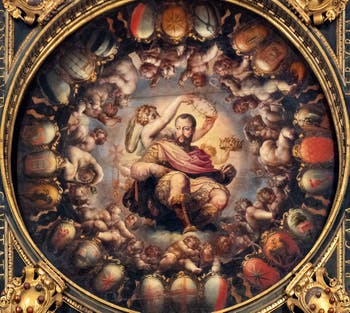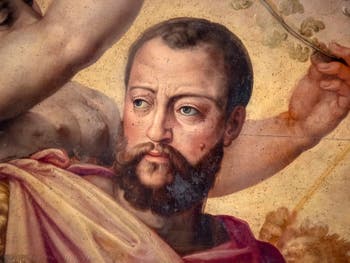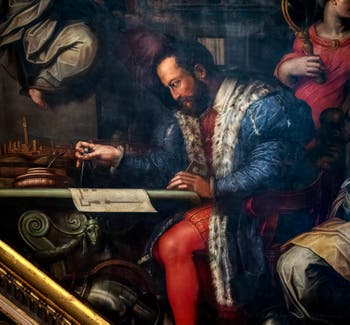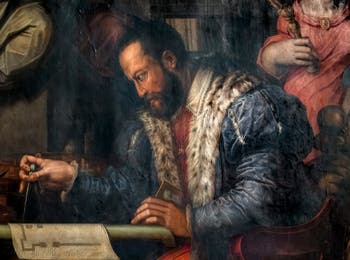Palazzo Vecchio Art Story | Location | Opening Hours Tickets | Authorizations
Art Story Five-Hundred | Tower | Vasari Halls | Dante Mask | Ghirlandaio | Bronzino Sarto Daddi | Salviati | Cortile
Five-Hundred Hall Hall and Ceiling | Ceiling Paintings | Pisa War | Siena War | Sculptures
Ceiling Paintings Cosimo I Medici | Florence History | Wars and Battles | Tuscany
Giorgio Vasari: Glorification of the Duke Cosimo I of Medici on the Ceiling of the Hall of Five Hundred of Palazzo Vecchio in Florence
Giorgio Vasari and Giovanni Battista Naldini, “The Apotheosis of Cosimo I of Medici”, Ceiling of the Hall of Five Hundred of Palazzo Vecchio in Florence
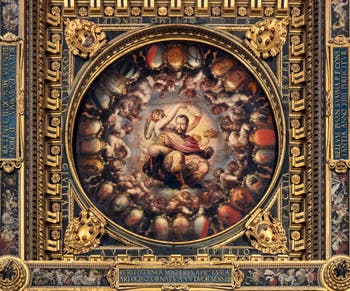
Apotheosis of Cosimo I of Medici The “tondo” (circular painting) of “The Apotheosis of Cosimo I of Medici” painted by Giorgio Vasari is located in the centre of the ceiling of the Five Hundred Hall of Palazzo Vecchio in Florence.
He is to the glory of Duke Cosimo de Medici, sponsor of the work and patron of Vasari, who described this painting as follows:
“I depicted Duke Cosimo triumphant and glorious, crowned by Florence with a crown of oak leaves. Florence is the principal city and metropolis of all its states [...]
I surrounded the Duke of twenty-four Putti representing the arts and the coat of arms of each of the governed states and cities.”
Giorgio Vasari
Duke Cosimo I Medici is thus represented under a crown of oak leaves held by Florence.
At the same time, one can see on his right the ducal crown raised by a putto and on his left another putto handing the cross of the order of St. Stephen founded by the Duke in 1561, as well as the decoration of the Golden Fleece, which he received from the emperor in 1545.
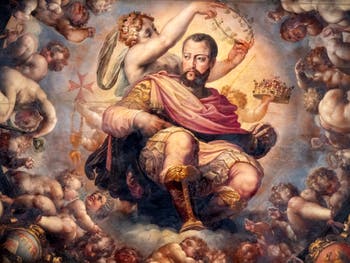
Apotheosis of Cosimo I of Medici The tondo is surrounded by inscriptions to the glory of Cosimo I:
“S.P.Q.F. Optimo Principi/Pacata Etruria/Aucto Imperio/Constituta Civitae” and the Ducal Coats of Arms without forgetting the various attributes of the Medici and references to his ventures for the good of Florence as well as to the two wars of Pisa and Siena.
Coats of arms are those of Florence, the people of Florence and the city of Florence.
The arts represented, clockwise and starting with the starry coat of arms to the left of the fleur-de-Lys, are those of bakers, wool workers, oil vendors, butchers, silks, laces manufacturers, tanners, furriers, shoemakers, linens and craftsmen, judges and notaries, carpenters, locksmith, doctors and herbalists, stonecutters and woodcutters, armourers, bankers, wine merchants, lumberjacks, drapers and innkeepers.
Giorgio Vasari and Giovanni Stradano, “The Duke Cosimo I of Medici studies the capture of Siena”, Ceiling of the Hall of Five Hundred of Palazzo Vecchio in Florence
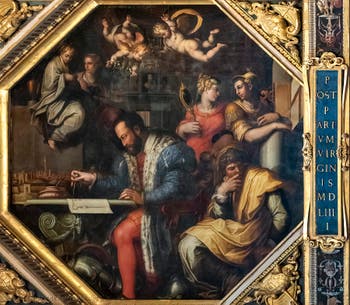
Cosimo I, capture of Siena The theme of this painting is the resolution of the Siena War.
It shows Duke Cosimo I of Medici at his working table in Palazzo Vecchio, developing his strategy to conquer the city.
We can see next to him a model of Siena as well as a map of the city that Cosimo I of Medici is studying in detail using a compass and a square that he holds in each of his hands.
Vasari depicted him surrounded by the virtues he possesses.
We see Patience, symbolized by a young woman holding an urn, while another young woman wearing a lamp represents Vigilance.
On the right, another young woman in a red dress that symbolizes Prudence.
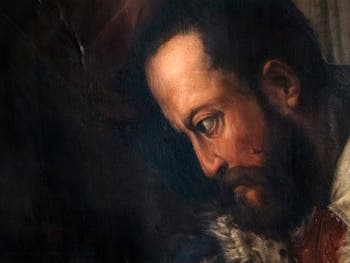
Cosimo I, capture of Siena With one hand, she holds a mirror and in the other a snake.
Next to her is a young soldier with a golden helmet, arms placed on a column.
He symbolizes soul strength, courage.
The last virtue of Silence, which accompanied Duke Cosimo I throughout this war, is represented by a man sitting on his right, with a finger on his mouth.
At the top of the table are represented two putti.
One bears a laurel wreath and the other an olive branch, both symbols of the ducal victory over Siena.
Under the painting is written: “BELLUM COGITANTES PRAEVENIT” which can be translated as “War is preparing by reflecting”.
Ceiling Paintings Cosimo I Medici | Florence History | Wars and Battles | Tuscany
Five-Hundred Hall Hall and Ceiling | Ceiling Paintings | Pisa War | Siena War | Sculptures
Art Story Five-Hundred | Tower | Vasari Halls | Dante Mask | Ghirlandaio | Bronzino Sarto Daddi | Salviati | Cortile
Palazzo Vecchio Art Story | Location | Opening Hours Tickets | Authorizations
Back to Top of Page


